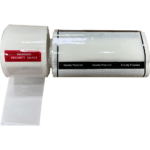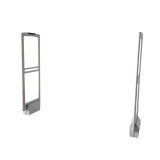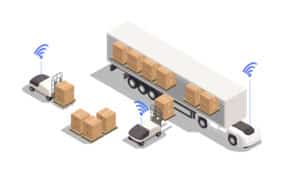In today’s world, security is a top concern for businesses across industries. Preventing theft and ensuring the safety of valuable assets is crucial, and one effective solution that has gained popularity is the Electronic Article Surveillance (EAS) anti theft system. With advanced technology and innovative features, EAS systems offer unparalleled security benefits. This article will explore the concept of EAS anti theft solutions and how they can optimize security for businesses.
What is an EAS anti theft system?
An EAS anti theft system is a security system used by businesses to protect their merchandise and assets from theft. This system primarily relies on three components: detection tags or labels, pedestals or antennas, and a control system. The detection tags or labels are attached to products and contain technology that triggers an alarm if not deactivated or removed properly. The pedestals or antennas are strategically placed at entry and exit points, and they detect the presence of the detection tags or labels. The control system manages the entire security system, including monitoring alarms, deactivation, and activation of the tags or labels.
Advantages of EAS anti theft solutions:
Deterrence: The presence of EAS antennas acts as a deterrent for potential shoplifters. The knowledge that there is a robust security system in place discourages theft attempts and reduces the number of incidents.
Real-time alarm: When a tagged item passes through the security gates with EAS antennas without proper deactivation or removal, an alarm is triggered. This immediate alert draws the attention of both customers and staff, enabling immediate response to potential theft.
Customizable options: EAS anti theft systems offer customizable options to meet the specific needs of different industries and products. Various types of tags, labels, and sensors are available, ensuring maximum protection for a wide range of merchandise.
Integration with existing security systems: EAS systems can be seamlessly integrated with existing security systems, such as cameras, access control systems, and alarms. This integration enhances overall security measures and enables centralized monitoring and management.

Industries that benefit from EAS anti theft systems
Retail sector: Retail businesses, including clothing stores, electronics shops, and supermarkets, can benefit greatly from EAS anti theft solutions. These systems protect merchandise from shoplifting, reducing losses and ensuring a secure shopping environment for customers.
Libraries: Libraries house valuable books and media that are prone to theft. Implementing EAS systems helps prevent unauthorized removal of materials, enhancing security and protecting the library’s valuable assets.
Museums and art galleries: Museums and art galleries display priceless artifacts and masterpieces. EAS anti theft systems with advanced sensors, such as RFID labels and security gates, can protect these items, ensuring their security without compromising the visitor experience.
Logistics and warehousing: The logistics and warehousing industry deals with the movement and storage of valuable goods. EAS anti theft solutions help prevent internal theft, track the movement of goods, and provide real-time monitoring, enhancing security and accountability.
Pharmacies: Pharmacies store a wide range of valuable medications, making them a target for theft. EAS anti theft systems protect medications from unauthorized removal, ensuring the safety of customers and the integrity of the inventory.
Conclusion
In conclusion, EAS anti theft systems offer businesses in various industries a reliable and efficient solution to optimize security and prevent theft. With features such as deterrence, real-time alarms, customization options, and integration capabilities, these systems provide enhanced security measures for businesses, resulting in reduced losses and a safer environment for customers and valuable assets. Investing in advanced EAS anti theft solutions is a proactive step towards protecting businesses and ensuring peace of mind in an increasingly security-conscious world.
Frequently Asked Questions
Q1. How does an EAS anti theft system work?
EAS anti theft systems work by using electromagnetic or radio frequency-based technology. They consist of tags or labels attached to products, pedestals or antennas placed at entry and exit points, and a control system that manages the entire security system. When a tagged item passes through the EAS antennas without proper deactivation or removal, an alarm is triggered, alerting security personnel.
Q2. Can EAS systems be integrated with existing security systems?
Yes, EAS anti theft systems are highly flexible and can be easily integrated with existing security systems, such as cameras, access control systems, and alarms. This integration provides a comprehensive security solution, enabling businesses to monitor and manage security from a centralized location.
Q3. Are EAS systems effective in preventing theft?
Yes, EAS systems are highly effective in preventing theft. The visual presence of EAS antennas acts as a deterrent for potential shoplifters. The alarm triggered by the system alerts both customers and staff, drawing immediate attention to any unauthorized or attempted theft. This discourages thieves and significantly reduces the risk of theft occurring.
Q4. Can EAS systems be customized for specific industries or products?
Yes, EAS anti theft systems can be customized to suit specific industries and products. Different types of tags, labels, and sensors are available, making it possible to protect a wide range of merchandise. EAS systems can be tailored to meet the specific security needs of businesses in various industries, enhancing security measures effectively.
Q5. Are EAS systems easy to install and maintain?
EAS systems are designed to be easy to install and maintain. Installation typically involves placing antennas at entry and exit points, attaching tags or labels to merchandise, and connecting the system to a control unit. Maintenance primarily involves ensuring the system is functioning correctly, replacing tags or labels as needed, and keeping the system updated with the latest software.


































